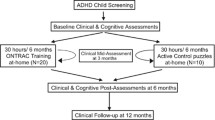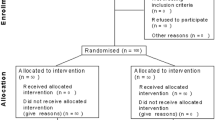Abstract
Smith-Lemli-Opitz syndrome (SLOS) is a genetic syndrome associated with multiple congenital malformations, mental retardation, and autism spectrum behaviors. This clinical protocol was part of a larger study investigating the effects of a cholesterol-lowering medication for SLOS patients. Behavioral therapists were consulted to facilitate participants’ cooperation with an overnight electroencephalogram (EEG). Seventeen children participated in one 1-hour training session of a mock EEG. Behavioral methods included task analysis, differential reinforcement, and escape extinction. Descriptive data reveal low cognitive and adaptive functioning. Fifty three percent of children tolerated all steps of the training procedure and 88% of participants tolerated all of the actual EEG procedure. Behavioral methods of training children may be an effective preparation for EEG procedures for children with SLOS. This study indicates that sedation, anesthesia, or restraints are not necessary to accomplish EEG testing of children with SLOS. Results may generalize to children with a range of disabilities.
Similar content being viewed by others
References
Dorenbaum, D., Mencel, E., Blume, W. T., & Fisman, S. (1987). EEG findings and language patterns in autistic children: clinical correlations. Canadian Journal of Psychiatry, 32, 31–34.
Dunn, W. (1999). The sensory profile manual. San Antonio: The Psychological Corporation.
Koontz, K. L., Slifer, K. J., Cataldo, M. D., & Marcus, C. L. (2003). Improving pediatric compliance with positive airway pressure therapy: the impact of behavior intervention. Sleep, 26, 1010–1015.
Lord, C., Rutter, M., & Le Couteur, A. (1994). Autism diagnostic interview-revised: a revised version of a diagnostic interview for caregivers of individuals with possible pervasive developmental disorders. Journal of Autism and Developmental Disorders, 24, 659–685. doi:10.1007/BF02172145.
Mehta, U. C., Patel, I., & Castello, F. V. (2004). EEG sedation for children with autism. Developmental and Behavioral Pediatrics, 25, 102–104. doi:10.1097/00004703-200404000-00005.
Roid, G. H. (2003). Stanford-Binet intelligence scales (5th ed.). Itasca, IL: Riverside.
Slifer, K. J. (1996). A video system to help children cooperate with motion control for radiation treatment without sedation. Journal of Pediatric Oncology, 13, 91–97.
Slifer, K. J., Koontz, K. L., & Cataldo, M. F. (2002). Operant contingency-based preparation of children for functional magnetic resonance imaging. Journal of Applied Behavior Analysis, 35, 191–194. doi:10.1901/jaba.2002.35-191.
Sparrow, S. S., Balla, D. A., & Cicchetti, D. V. (1984). Vineland adaptive behavior scales: Survey form manual. Circle Pines, MN: American Guidance Service.
Tierney, E., Nwokoro, N. A., & Kelley, R. I. (2000). Smith Lemli-Opitz syndrome. Child and Adolescent Psychiatry, 40, 506–507.
Tierney, E., Nworko, N. A., Porter, D. F., Fruend, L. S., Ghuman, J. K., & Kelley, R. I. (2001). Behavior phenotype in the RSH/Smith-Lemli-Opitz syndrome. American Journal of Medical Genetics, 98, 191–200. doi:10.1002/1096-8628(20010115) 98:2<191::AID-AJMG1030>3.0.CO;2-M.
Tint, G. S., Irons, M., Elias, E. R., & Batta, A. K. (1994). Defective cholesterol biosynthesis associated with the Smith-Lemli Opitz syndrome. The New England Journal of Medicine, 330, 107–113. doi:10.1056/NEJM199401133300205.
Tucker, C. L., Slifer, K. J., & Dahlquist, L. M. (2001). Reliability and validity of the brief behavioral distress scale: a measure of children’s distress during invasive medical procedures. Journal of Pediatric Psychology, 26, 513–523. doi:10.1093/jpepsy/26.8.513.
Acknowledgements
This research was supported in part by Autism Speaks, the Intramural Research Program of the National Institute of Child Health and Human Development (NIH), the Johns Hopkins General Clinical Research Center M01-RR00052, KKI NIMH-funded Studies to Advance Autism Research and Treatment Center 154MH066417, the National Institute for Child Health and Human Development Mental Retardation and Developmental Disability Research Center P30HD24061, and the KKI Center for Genetic Disorders of Cognition and Behavior.
Author information
Authors and Affiliations
Corresponding author
Rights and permissions
About this article
Cite this article
DeMore, M., Cataldo, M., Tierney, E. et al. Behavioral Approaches to Training Developmentally Disabled Children for an Overnight EEG Procedure. J Dev Phys Disabil 21, 245–251 (2009). https://doi.org/10.1007/s10882-009-9139-7
Published:
Issue Date:
DOI: https://doi.org/10.1007/s10882-009-9139-7




